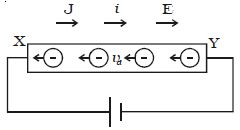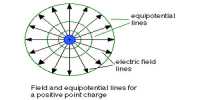Drift velocity is defined as the velocity with which free electrons get drifted towards the positive terminal when an electric field is applied.
If τ is the average time between two successive collisions and the acceleration experienced by the electron be a, then the drift velocity is given by,
vd = aτ
Consider a conductor XY connected to a battery (Figure). A steady electric field E is established in the conductor in the direction X to Y. In the absence of an electric field, the free electrons in the conductor move randomly in all possible directions.

Fig: Current carrying conductor
They do not produce current. But, as soon as an electric field is applied, the free electrons at the end Y experience a force F = eE in a direction opposite to the electric field. The electrons are accelerated and in the process, they collide with each other and with the positive ions in the conductor.
Thus due to collisions, a backward force acts on the electrons and they are slowly drifted with a constant average drift velocity vd in a direction opposite to electric field.













